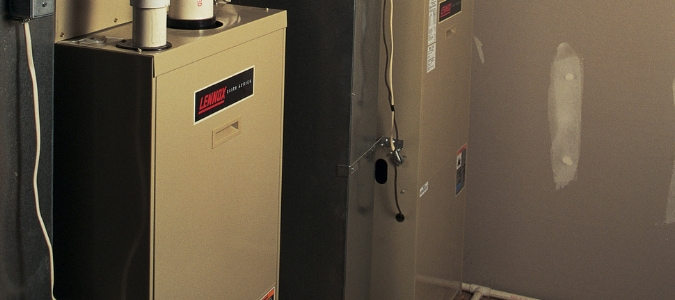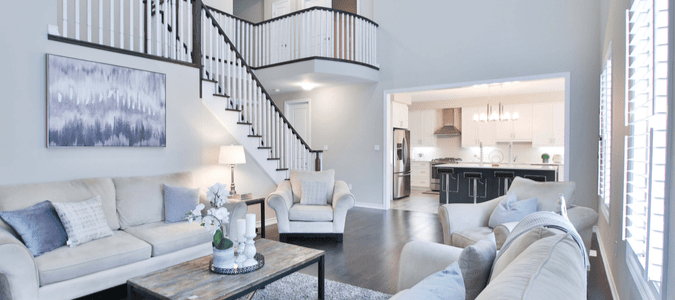
No homeowner wants to be hit with a surprisingly large utility bill. With so many other things on your plate, it can be hard to determine exactly why your energy costs might have skyrocketed suddenly, or why your monthly costs have gotten so expensive over time. If you find yourself in the position of asking yourself: Why is my electric bill so high?, you should know that while there are actually a number of factors that could be responsible, the most likely is a problem with your heating and cooling system.
Air Conditioning Or Heating Issues
You may not realize that keeping your home at a comfortable temperature typically accounts for nearly half of your energy use for any given month. Reviewing your billing history is always a good place to start your research if you feel something is amiss. Check your current statement against the same month one year ago. In some cases, you may see that you experienced a similar spike last year at this time. It’s also possible that this year’s weather is unseasonably warm (or cold), so your air conditioner or heater had to work much harder during your last billing period than it normally does.
If you do find that your energy usage is up significantly over last year, and temperatures have not been extreme, you may want to bring in a licensed air conditioning repair person to check your system for problems. While your heating and cooling system is complex, a few of the common problems are dirty filters, thermostat problems, restricted airflow and inadequate maintenance.
Dirty Filters
Dust, pet and human hair and other materials accumulate in your air filters over time, which results in your system working harder than it should to circulate air. A majority of AC issues are linked to clogged filters. In most homes, replacing or cleaning air filters every 30 to 60 days is adequate. If you have pets or during peak heating and cooling seasons, you may need to swap out your filters even more often than that.
Thermostat Problems
If the temperature in your home doesn’t match what’s on your thermostat, it could be that the reading is off if your thermostat is in direct sunlight. There are other problems associated with your thermostat which could impact its ability to keep your home at its desired temperature. Most of these types of problems are better addressed by a professional.
If you don’t already have one, you can consider installing a programmable thermostat in your home. Your indoor temperature can be set to cost-efficient levels for the season, and to automatically adjust to accommodate periods of sleep or when your home is empty. You can cut your heating bill by between 5% and 15% if you set your thermostat 10 to 15 degrees lower for 8 hours. Once your system is programmed, try changing your clothes instead of the system if you become uncomfortable. Add a layer when you get chilly or switch to looser-fitting clothes when you get too warm to save on energy.
Restricted Airflow
The compressor, which is the part of your system which is outdoors, needs to be 2 to 3 feet away from any vegetation to circulate air properly. If you are troubleshooting the problem on your own, also make sure that there is at least 5 feet between the top of your compressor and any nearby trees.
Inadequate Maintenance
By checking your system twice a year—once in the fall before heating season starts and once in the spring before you use your air conditioning—you can catch any potential headaches and run diagnostic tests to ensure your system is working at peak efficiency. A technician can look at your refrigerant level and examine many other important components and make any necessary adjustments.
Have you started experiencing more frequent and larger repairs now that you have had your unit for over 10 years? In some situations, rising costs can indicate it’s time to consider a system replacement. An experienced technician can give you honest advice about whether you need to consider switching out your current unit for a newer, more energy-efficient system that may qualify for federal and local rebates.
Billing Cycle Changes And Unexpected Fees
Depending on how your billing dates fall, the exact number of days of energy use could fluctuate a bit from one month or season to the next. While you typically don’t see anything more than a few days’ difference, your current bill could be higher as a result. When rates change or other fees pop up for other utilities, you may also notice a bigger number on your monthly statement.
How can you avoid these issues? If your provider offers the option, you might want to consider enrolling in a budget plan. This is typically available after your first year of service if you have no history of late or missed payments. Essentially, providers track 12 months of usage and take the monthly average to create a set bill payment for you.
While this does mean you’ll pay more in the months you would traditionally enjoy a lower total, the energy bills for the warmer and cooler months would remain even instead of you having to come up with extra funds to cover normal usage spikes. It should also help you avoid unexpected fees because they’re harder to hide if your payment is always the same.

Entertaining Guests
We don’t often think about the impact that having extra bodies in the house can have, but sometimes the difference can be significant. From showers to cooking appliances to light switches and electronics, every feature in your home was likely being used more than normal if you had guests stay with you for extended periods of time.
Here are a few ways you can offset the impact of having guests:
- Turn down your hot water heater temperature. The ideal temperature is 120 degrees. Lower the temperature by a few degrees (or shut this appliance off completely when you’re gone) and garner big savings. Just inform your family members when you do this so they aren’t left wondering why your gas water heater isn’t hot enough.
- Ask that everyone wash their clothes in cold water. Avoiding hot water is also better for the environment and easier on your clothing.
- Be vigilant about turning off lights and appliances when rooms are not in use. Switching off fans, lights, appliances and other energy “vampires” save you in the long run.
Remodeling, Rearranging Or Adding Appliances
We have already mentioned that heating and cooling make up half your utility bill. Your lighting and major appliances generally account for the other half. So, if you’ve recently made some new purchases, pay close attention. Sometimes we don’t realize just how much energy a new appliance is going to require. A new pool, bedroom or outdoor living space can make a surprisingly big difference in your energy use.
Likewise, if you’ve recently moved anything around, make sure you didn’t inadvertently block important ventilation areas or leave an area less protected from outside weather conditions. Or, if you renovated to add space, confirm that your heating and cooling system is the proper size for your new square footage.
Are there ways to “fix” these issues? It depends. When you check the ventilation of your appliances and find your refrigerator’s new spot isn’t as ideal as you first thought, your best option is to move it. If your heating and cooling system isn’t equipped to handle the extra space, you may have a tougher decision to make, that might involve getting a more powerful unit or adding a separate one.
Poor Insulation
Another likely culprit of an unusually high electric bill is improper insulation. If your energy costs have always seemed unusually high and you have ruled out other issues, you may want to investigate possible air leakage and add insulation. Air conditioning contractors typically offer home energy audits which can identify what improvements can be made.
Addressing these issues can range from a fairly involved do-it-yourself project to a massive undertaking, depending on your home and the circumstances. Start by checking doors and windows for breaks in the seals and gaps that allow air to pass through, and make a note when you find something that doesn’t seem quite right. Caulk and weatherstripping can help fill cracks. Older windows and doors can be replaced to save on energy costs.
If you run through all the possible reasons for a high electric bill and conclude that it’s time to invest in a new heating and cooling system, you probably will want to get up to speed on how to choose the most energy-efficient units.

What Is A SEER Rating?
A SEER rating, or Seasonal Energy Efficiency Ratio, describes how much energy it takes for your air conditioner to operate over the course of a single year.
The U.S. Department of Energy sets minimum efficiency rating standards that all new heating and cooling units must meet. Most units on the market today actually exceed these requirements, ranging from 13 to 25 SEER.
The less energy your heating and cooling system uses, the more efficient your unit is considered to be and the higher the SEER rating it will have. Exactly how much you save on your utility bill each month with a better SEER rating will depend on these primary factors:
- The size of your home
- How much you pay per kilowatt-hour
- Your current unit’s SEER rating
- What it costs to heat or cool your home now
Heating and cooling your home is the biggest contributor to energy use in homes, so the most straightforward way to reduce your energy costs is to replace your unit with one that had a higher SEER rating. In some cases, however, you may be looking for other options to lower your electric bill that don’t involve paying for a whole new system.

How To Lower My Electric Bill Without Replacing My Unit
If you aren’t at the point where you can invest in a new unit, you have a few options to cut your monthly utility bill. The easiest is to start dressing according to the weather. If you’re chilly, throw on a sweatshirt and a pair of socks. Conversely, if you’re warm, change into a t-shirt and shorts.
Since air filters are the most common reasons for heating and cooling systems not working at peak efficiency, as we have already mentioned, you may need to change how often you are replacing or cleaning your air filters. Ideally, you should be checking your filter every 30 to 60 days. These parts can become clogged with dust, pet dander and other particles over time, and as the filters become clogged, your unit has to work harder to heat or cool your home. Changing your air filters regularly will not only lower your electricity bill, but it can also help with respiratory problems if anyone in your household is particularly susceptible. Dirty air filters may also be the reason why cold air is blowing out of your vents when the heat is on if you have noticed this is happening in your home.
You can also call your local utility company and ask about surge hours. During these hours, more people are using energy the most, and costs are higher. Usually, surge hours are around 4pm to 7pm—about the same time people are getting home from work. If you can avoid running your heating and cooling system, dishwasher and other appliances during those times, it can help you save on your electricity bill.
Of all of the things you can do, adding insulation is one of the best ways you can lower your electricity bill. Proper insulation can help keep warm air in and cold air out. As our electricity bills get higher, insulation is often something homeowners forget about as they don’t realize that insulation doesn’t last forever.
How Long Does Insulation Last?
If your home was built before the 1980s, chances are that insulating exterior walls was not a standard practice. That means there’s nothing in your walls to protect you from the outside elements at all. Even those homes that were insulated should have had insulation improvements done at least twice by now, and maybe looking at a third time sooner than later.
This is because, normally, insulation lasts about 15 years before deterioration begins to result in inefficiencies. Sometimes the material breaks down sooner if issues like water leaks and other damage are present. One quick and easy way to gauge whether insulation needs to be added is by going up in your attic and taking a quick glance across the floor. If you can see the floor joists above the insulation, you probably need more insulation.
When you can’t see the joints, pull out a ruler to be sure. Round the number of inches down to the nearest whole inch, and multiply that number by (3). This gives you what’s known as the “R-value” of your insulation. Your R-value is the measure of your insulation’s ability to resist heat flow. The higher it is, the better it performs thermally. The industry rule of thumb is to keep your value around R-38 when using fiberglass or cellulose insulation (the most common types). If you calculate a difference of 13 or more, additional insulation is likely needed to garner energy savings.

How To Insulate A Home With Existing Walls
While we typically think about insulation in our attics, other parts of your home can benefit from the addition of these materials. If you add insulation in your attic and your home continues to feel drafty, you may want to consider adding insulation to your exterior walls. The easiest time to do this is when you are remodeling and there are existing wall cavities which give you easy access to these spaces.
If you plan on insulating your walls yourself, you’ll need to head to the home improvement store to either buy or rent special tools. If you aren’t currently remodeling, you will have to cut holes into the interior or exterior walls, and blow the new insulation into your wall cavities with special equipment. If this sounds like a project you want to tackle, you’ll want to set aside adequate time for this relatively intensive task. Once you’ve added in adequate insulation, depending on whether the holes are in your interior sheetrock or exterior siding, the cleanup and patching processes will be different.
Your three different options for insulation materials are:
- Fiberglass insulation
- Cellulose insulation
- Foam insulation
Many homeowners choose to outsource this project to professionals who can manage the process from inspection to cleanup. An air conditioning contractor or handyman is also likely to complete the project much more quickly than you can on your own simply because they’ve done it so many times before.
ABC Can Make Your Home More Energy Efficient
While insulation helps, you have many options if you want your home to be more energy-efficient, such as improving your indoor air quality and applying solar film to your windows. At ABC Home & Commercial Servies, we offer complimentary inspections and estimates to help you decide the best strategy to lower your monthly bills. Our pros can also give you advice on whether it would be more cost-efficient to replace your current system or keep paying for your abnormally high electric bills. Once you have decided what makes sense for you and your home, we can implement any measures that will make your indoor environment more comfortable and your electric bill more consistent.
